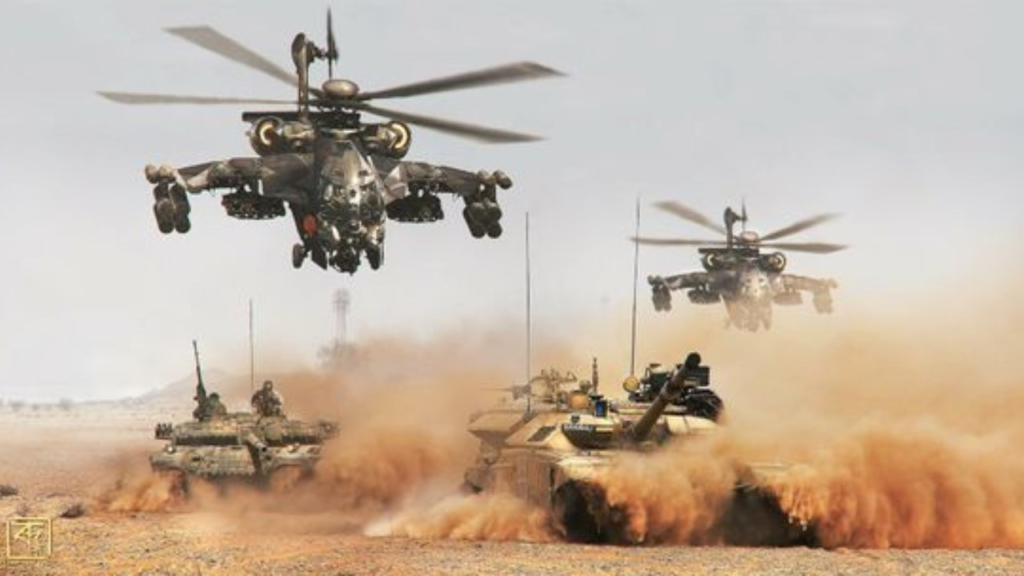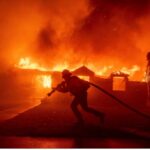The single bloodiest conflict in world history, World War III, also known as Putin’s orgyfest, claimed over 200 million lives directly.
Many nuclear bombs dropped on cities such as Shanghai, Paris, St. Petersburg, and Boston throughout the war killed around 20 million people.

The start of the World War III
Most people agree that the World war III began on April 30, 2027. following the contentious choice to station nuclear-armed missiles in the Ukrainian L’viv Oblast. Russia ordered that the nuclear weapons be evacuated within 48 hours or formal relations would be severed, which caused a significant diplomatic impact from the decision.
The conflict began with a combined military advance by Belarus and Russia against L’viv, which was quickly repulsed by forces from Poland and Romania that were advancing from the west and the south. But Russian firepower had proven too formidable to overcome. After capturing the nuclear missiles, Russia returned them to its territory for examination and disarmament. Additionally, pro-NATO President Yuriy Carnovsky was driven from office by Russian soldiers, who also asked that NATO remove its MAP for Ukraine.
While in exile in Warsaw, President Yuriy Charnovsky declared that “Ukraine must join NATO at any cost” in response to demands made by the US and its NATO allies on April 29, 2027, demanding that Russia return the missiles and remove its forces from Ukrainian territory. NATO demanded that Belarus and Russia leave Ukraine and make up for the approximately $75 million in damages that the city of L’viv sustained as a result of Russian strategic bombardment.
The officially start of the War
With the US and NATO declaring war on Russia on April 30, 2027, the entire CSTO agreement—which includes Kazakhstan, Kyrgyzstan, Mongolia, Tajikistan, Iran, and Armenia—came into effect. China, Pakistan, and North Korea were compelled to enter the conflict due to the activation of the SCO military framework and the Sino-Russian friendship pact.
In the Battle for the Baltic, Belarusian forces were entrusted with capturing the Baltic republics because Russians are gay. The Russians captured all of the Baltic republics in as short as 48 hours; the Russians suffered 5,000 casualties, while the combined Baltic army suffered 3,000 losses and was now left to fight against Russian domination. According to leaked documents, Sergei Shoigu was preparing to negotiate a settlement to stop a full-scale European war. However, all talks were utterly disrupted by the invasion of the Baltic nations, and the conflict had now intensified.
In order to prevent the US from sending forces in time, Russia chose to advance westward into Poland and Germany. Next, Poland and the Baltics would be downgraded to NATO Observer status, and Russia would negotiate the complete withdrawal of Finland’s and Ukraine’s NATO membership action plans. The Russian high command chose to adopt a defensive stance in Belarus, Ukraine, and the Baltics after realising that the mission was impossibly difficult. The Russians eventually put a sizable force on the Finnish-Russian border after realising that if Finland joined the war, the backup preparations would become considerably more challenging.
Finland attacked the ancient Finnish territory of Karelia and formally declared war on Russia, sparking the start of the conflict of Karelia. The Karelian operation was originally successful, but the Finnish-NATO push into Karelia was severely hampered by the intense fire from strategic missile systems in both Russia and the Kola peninsula. Around June 2027, the frontline stabilised, with 13,000 men lost by the Finnish forces and about 20,000 Russian fatalities.
NATO starts to assemble
Several NATO members, including Germany and Italy, flatly refused to convert their economies to produce weapons of mass destruction. They also fell short of meeting multiple requirements, including the supply of troops, tanks, and mobilised battalions for the NATO campaign against Russia. Germany had typically advocated for a settlement and had spoken out against the previous decision to station weapons in Ukraine. Since many western European states chose to forgo total war, believing that the conflict would not worsen, the bulk of the labour force was now American and Eastern European.
The Polish army launched the first coordinated invasion into west Ukraine, targeting the oblasts of Grodno in Belarus and L’viv in Ukraine, respectively. Polish forces were supported by insurgents in Ukraine, and as a result, the Poles were able to establish themselves in Russian-occupied Ukraine. They did, however, suffer a great deal of fatalities; the Poles reported as many as 5,000 deaths.
The War in the Pacific
Japan had declared war on the CSTO as well as on China and Russia during this period. The vast majority of the Russian army still remained in European Russia, thus the Japanese were eager to reclaim what they believed to be Japanese land in the Sakhalin Islands. As a result, their initial drive into the islands was mostly unopposed. After demanding that Russian soldiers leave the northern half of the Sakhalin Islands, Japan annexed the southern portion of the archipelago.
China had started preparing for war by this point, but it was still unclear if China would actually play a significant role in the conflict. This all changed, though, when the Japanese bombed Beijing in a manner reminiscent of Pearl Harbour, which had occurred nearly a century earlier. The Chinese were infuriated by this, and they launched a massive amphibious attack into the island of Okinawa, destroying every American post that was situated there. The fight dealt a serious blow to American morale because the once-invincible American navy was routed, suffering 4000 casualties while disheartening the invading Chinese forces with 6500 casualties.
Local officials were invited to the Republic of Okinawa’s proclamation ceremony by the Chinese soldiers, but they had all already left to avoid the Chinese invasion. Rather, the Okinawans had hoped for a return to normalcy but instead had just accepted the new status quo.

Europe starts to get structured
As the war intensified, a number of reserve troops in Germany, France, and the UK mobilised under the auspices of the NATO alliance. When worries of thermonuclear war peaked, Germany, France, and the UK decided to switch to semi-war production, started directing funds to important defence companies, and started conscription. This led to the development of a sizable anti-war movement. A number of European states flatly refused to adopt a war economy, and several even withdrew from NATO. Under Recep Tayyip Erdogan, Turkey withdrew from NATO and announced its neutrality; Greece and Serbia staged pro-Russian coups and joined the CSTO side of the conflict instead. A number of nations declined to contribute the required number of soldiers and supplies, including Iceland, Greenland, Spain, Portugal, Italy, and Greenland.
Due to their de facto declaration of neutrality and fear of thermonuclear war, this group of nations which came to be known as the “Lost Group” or the “Traitors” only supplied modest numbers of troops and equipment. Just 200,000 soldiers from these five nations fought in all during the conflict, most of them in occupation and civilian roles rather than direct combat. These countries took only 10,000 casualties in total.
Pacific Warfare
Following Vietnam’s conquest of the Spratly islands from the Chinese navy, the Chinese launched a huge amphibious and ground assault into Vietnam; about 500,000 men were involved in the first assaults on both sides. From Laos, Cambodia, and Guangxi province on the west and north, respectively, the Chinese troops swiftly moved into Vietnam. After a month of fierce warfare, the Chinese army reached Hanoi; the Vietnamese army claimed 25,000 deaths while the Chinese suffered over 30,000. Almost 50,000 Vietnamese soldiers lost their lives in the Battle of Hanoi, which saw Chinese tanks enter the city and effectively destroy the Vietnamese army.
Following the battle, the front line became impassable, and the Vietnamese made multiple attempts to drive the Chinese back, only to be met by overwhelming Chinese firepower. The “Rape of Hanoi” was one of the most horrific war crimes committed by the Cambodian army, during which its forces stormed the city, raping and killing over ten thousand civilians. The Chinese were already having a great deal of difficulty conquering the northern part of Vietnam when the Hanoi massacre occurred. As word of the massacre spread, it led to massive uprisings in the areas that the Chinese had taken over.
The majority of ASEAN nations, with the exception of Cambodia and Laos, had denounced the invasion, which startled the neighbouring countries. As the only nation in ASEAN to declare war on China, the Filipinos rallied in support of the Vietnamese. As soon as the war officially started, the US launched naval operations in the South China Sea.
The allied attack on Russia by NATO
The Russian and Belarusian soldiers still possessed superior weaponry within the city and its environs, while the NATO armies’ position had come to a standstill around the ancient city of L’viv. The primary issue with the Polish onslaught is the L’viv Oblast’s urban and forested terrain, which made armour and infantry pushes difficult. With most of the city under lockdown, the Polish army chose to avoid the city, cut off supplies, and wait for a determined Russian advance into the central regions of Ukraine. The Russians used a range of urban warfare tools to fortify the city and its environs.
Large-scale airstrikes and artillery barrages marked the start of the offensive, which was then followed by a massive armoured drive into the L’viv Oblast and Galicia region. The main drive was quickly shifted towards the remainder of the province as the Russians started to retreat in huge numbers. The initial advance instantly forced a Russian withdrawal within the city as the NATO troops began surrounding the city.
After about two weeks, the Russian army had lost three-quarters of the province, and large-scale uprisings against Russian rule started to occur in the Western and Central regions of Ukraine. The Russians still possessed sizable troop formations in central Ukraine that could invade the Western province, so the Romanian The Russian onslaught was expected to start shortly, so Hungarian and Croatian soldiers tented out near the Dniester river and strengthened their fortifications.
The Russians never launched an invasion; instead, they redirected forces to put down uprisings in central Ukraine and strengthened their own holdings there, building substantial fortifications along the Southern Bug River. The second phase of the war had now begun.
China and Russia arranged the “Harbour Freight” plan the following day. Disguised planes dropped over 200,000 SCO and CSTO troops throughout Alaska, quickly overrunning the USAF bases. Following that, Vladimir Putin gave the order to launch multiple cruise missile strikes against the US West Coast, which let multiple North Korean divisions to land there.
The Unmodern KPA forces were repelled by US troops in Fort Lewis, Washington, while the Army National Guard’s 40th Infantry Division was soundly defeated in Los Angeles and San Francisco. In order to support the defence of the US mainland, the US withdrew some forces from Europe, but Russia is rapidly fortifying its borders in Eastern Europe.
The combined Taiwanese and Filipino ships were confronted by Russian and Chinese naval fleets in the South China Sea two months later. Only 45% of the Taiwanese and Philippine ships remained, despite the fact that the Chinese and Russians declared victory and lost 70% of their ships. Russian and Belarusian troops will spearhead the “Sickle Harvest” offensive in Europe.
American and Canadian ground soldiers are dispersed throughout Western Canada and the Rocky Mountains.
In the occupied zone, armed civilians from the United States are being fought by Chinese and KPA troops. In occupied Anchorage, US Army Rangers, Seals, and MARSOC are dropped.










